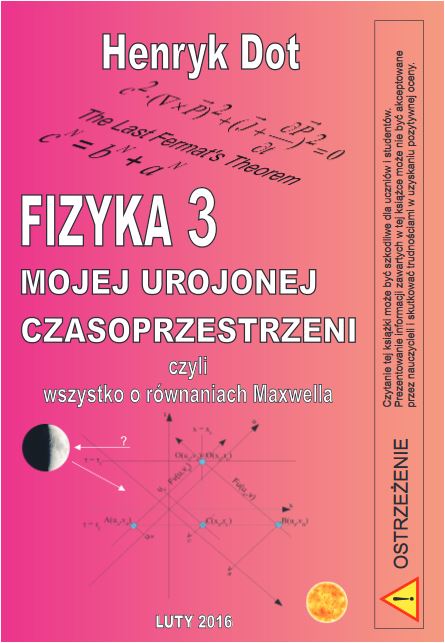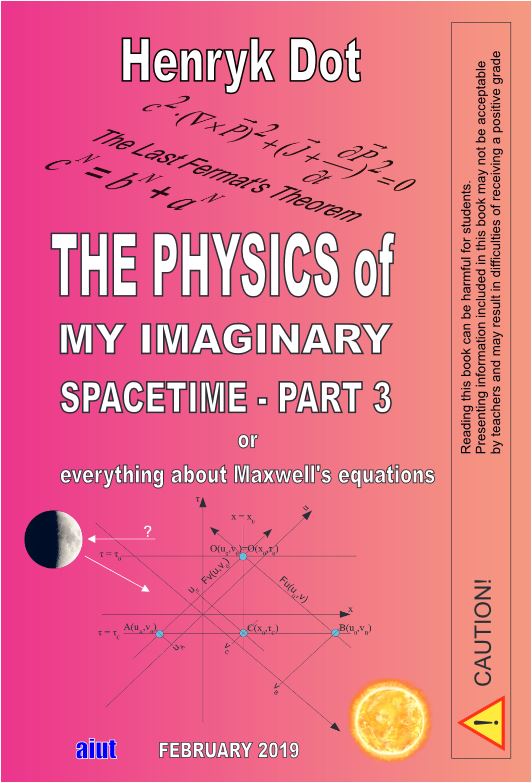★ HenrykDot.com
★
is the online companion to a series of books published by AIUT under the common main title
"Physics of My Imaginary Space-Time" by Henryk Dot.
is the online companion to a series of books published by AIUT under the common main title
"Physics of My Imaginary Space-Time" by Henryk Dot.
Home
Physics 3 - Maxwell
Note from the Author
Table of Contents
What is this book
Historical facts
New aspects
Fully erroneous
Incorrectly interpreted
Physics 3 - Chapter 1
Equations
Complex vectors form
The Most General form
The General Solution
Physics 3 - Chapter 2
Solutions
Initial conditions
Non-homogeneous equation
Solution for three-directions
The four laws
Physics 3 - Supplement
Fermat's proof
Beal's conjecture
Pythagorean triples
Inertial mass
Gravity constans big G
What does the Moon look at?
Physics 3 - Final notes
Final notes
Physics 4 - New book
Entry
Physics 3 - Maxwell
Note from the Author
Table of Contents
What is this book
Historical facts
New aspects
Fully erroneous
Incorrectly interpreted
Physics 3 - Chapter 1
Equations
Complex vectors form
The Most General form
The General Solution
Physics 3 - Chapter 2
Solutions
Initial conditions
Non-homogeneous equation
Solution for three-directions
The four laws
Physics 3 - Supplement
Fermat's proof
Beal's conjecture
Pythagorean triples
Inertial mass
Gravity constans big G
What does the Moon look at?
Physics 3 - Final notes
Final notes
Physics 4 - New book
Entry
Contact
email: henryk.dot(at)aiut.com
"Subject" should begin with
a digit corresponding to the day
of the week., e.g. Sunday=7
"Subject" should begin with
a digit corresponding to the day
of the week., e.g. Sunday=7
Books published by AIUT
are found in libraries according to the list of compulsory copies.
Second Edition of "Fizyka 3"
ISBN 978-83-926856-1-6

can be bought in Warsaw
in the Academic Bookstore
PW Publishing House
Noakowskiego street 18/20
and in Katowice
in the bookstore "Liber"
Bankowa street 11.
(area of Silesian University)
English edition of "Physics"
ISBN 978-83-926856-2-3

is also in libraries
and the distribution method should be asked wydawca@aiut.com.
| Table of Contents | |
| Preface for the English edition | 4 |
| Note from the Author | 6 |
| Table of Contents | 8 |
| Introduction | 10 |
| I.1. What is this book all about? | 10 |
| I.2. Interesting historical facts regarding Maxwell’s equations | 11 |
| I.3. New aspects regarding Maxwell’s equations | 16 |
| I.4. Fully erroneous ideas regarding Maxwell’s equations | 20 |
| I.5. Incorrectly interpreted specific problems | 21 |
| I.6. References | 23 |
| Chapter 1. Equations | 24 |
| 1.1. Symbols and notations used | 24 |
| 1.2. The most general form of Maxwell’s equations | 25 |
| 1.3. Derivation of complex form of vector for fields E and B | 26 |
| 1.4. Application of complex notation allows for the most general form of equations | 30 |
| 1.5. Even More General Notation of Equations | 32 |
| 1.6. General Solution of Maxwell’s Equations | 33 |
| Chapter 2. Maxwell’s Equations Solution | 36 |
| 2.1. Proper solution of Maxwell’s equations | 36 |
| 2.2. One-direction solution | 37 |
| 2.2.1. Solution for homogenous equation | 37 |
| 2.2.2. Boundary/Initial conditions problem | 42 |
| 2.2.3. Solution for nonhomogeneous equation | 48 |
| 2.3. Solutions for three-directional equation | 57 |
| 2.3.1. Solution for three-directional homogenous equation | 57 |
| 2.3.2. Solution for nonhomogeneous equation | 61 |
| 2.3.3. Correct interpretation of inverse square law | 64 |
| 2.3.4. Biot- Savart’s law in Maxwell’s equations | 66 |
| 2.3.5. Coulomb’s law in Maxwell’s equations | 68 |
| 2.3.6. Faraday’s induction law in Maxwell’s equations | 69 |
| Supplement – Mathematical problems and other issues | 72 |
| 3.1. Short and simple proof of Fermat's theorem | 72 |
| 3.1.1. Andrew Beal’s conjecture | 74 |
| 3.1.2. Pythagorean triples | 75 |
| 3.2. The origin of inertial mass and equation E = mc2 | 78 |
| 3.3. The relation between gravitational constant G and speed of light | 79 |
| 3.4. Why Moon in first and last quarter phase does not “look at” the Sun | 81 |
| Final notes | 85 |
© 2020 Henryk Dot -
